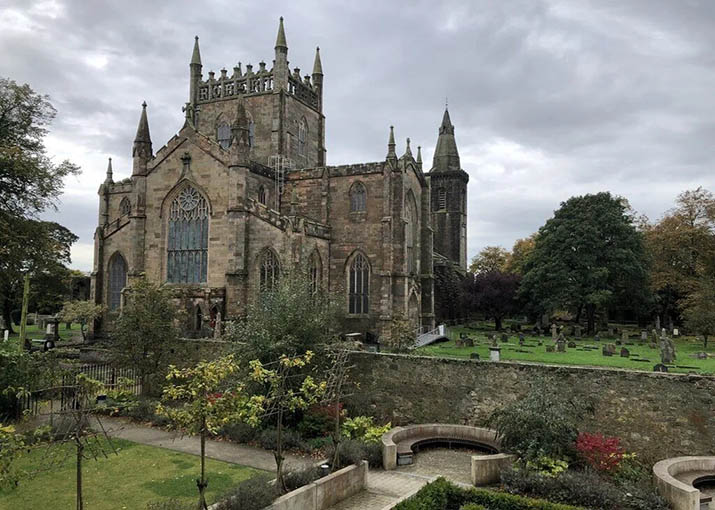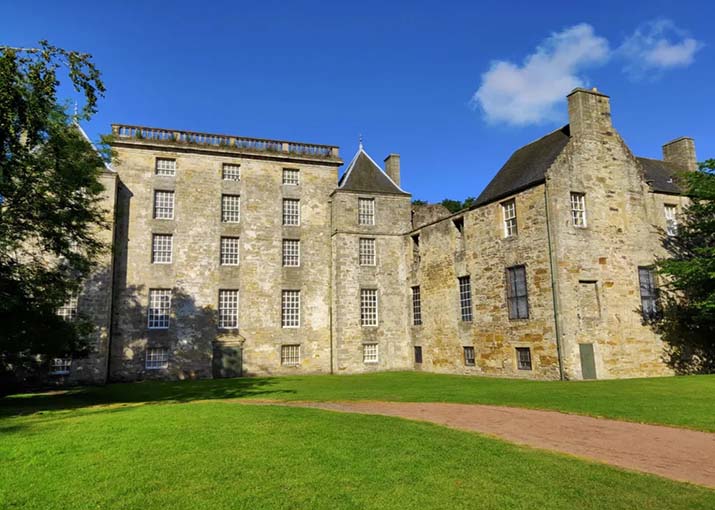Nestled in the heart of the historic town of Dunfermline, Scotland, the Dunfermline Royal Gardens is a place where nature, history, and tranquility converge. Having visited many gardens around the world, I can say with certainty that these gardens stand out as one of the most beautiful and serene spots I have had the pleasure to explore. A visit to the Royal Gardens is not just a stroll through meticulously manicured lawns, but a journey through time, surrounded by the echoes of Scotland’s royal history. This article is my personal account of exploring the Dunfermline Royal Gardens, with all the details about the gardens, the best activities, and essential tips for making the most of your visit.
Location: Where It All Begins
Dunfermline Royal Gardens are located in the heart of Dunfermline, Fife, Scotland. The gardens are part of the larger Dunfermline Abbey and Palace, making it one of the most historically significant sites in Scotland. The gardens themselves stretch across 11 acres, offering visitors a vast expanse of green, including ornamental flowerbeds, tranquil ponds, ancient trees, and impressive sculptures.
Getting There
Located just a short walk from the town center, the Royal Gardens are easy to access. From the Dunfermline bus and train stations, it’s only a few minutes by foot. I highly recommend taking a stroll through the town’s streets before heading to the gardens, as Dunfermline’s charming architecture adds to the overall experience.
The Historical Significance of Dunfermline Royal Gardens
As I wandered through the Royal Gardens, I couldn’t help but feel a deep sense of history. This place is more than just a park—it’s a piece of Scotland’s royal past. Dunfermline was once the capital of Scotland, and it is here that King Robert the Bruce, one of Scotland’s most famous kings, was buried. The Royal Gardens are a part of the historic Dunfermline Abbey, which dates back to the 12th century. The gardens were originally designed as a royal retreat, and their beauty remains a testament to the grandeur of Scotland’s medieval royalty.
As I sat by one of the many peaceful ponds, I took a moment to reflect on the fact that the Abbey was once a bustling royal court, and the gardens were a haven for royalty seeking respite from the duties of the crown. It’s hard not to be awed by the centuries of history that have unfolded in this very spot.
The Beauty of the Gardens
1. The Ornamental Flower Beds
One of the most striking features of the Royal Gardens is the stunning collection of ornamental flower beds. The gardens are carefully maintained with vibrant flowers that change with the seasons, providing a beautiful canvas of color throughout the year. When I visited, the spring blooms were in full swing, with daffodils, tulips, and crocuses carpeting the landscape in brilliant hues of yellow, purple, and red.
The flowers are carefully arranged in intricate patterns, offering a glimpse into the art of formal gardening that has been perfected over centuries. I spent hours simply admiring the beauty of the plants, taking in their scent, and listening to the birds chirping in the trees above.

2. The Tranquil Ponds
As I wandered deeper into the gardens, I came across a series of tranquil ponds surrounded by lush greenery. These serene bodies of water provide a perfect place for reflection. Sitting by the pond, I was able to take in the beauty of the gardens from a different perspective. The reflections in the water seemed to double the beauty of the surrounding trees and flowers. Some of the ponds have small bridges that allow you to cross over and take in the view from all angles.
3. The Ancient Trees
Among the most impressive features of the Royal Gardens are the ancient trees. Many of these trees are several hundred years old, some possibly older than the gardens themselves. I found myself walking slowly along the winding paths under their towering branches, marvelling at their size and age. Some of the trees are so large that it takes several people to encircle their trunks.
These trees have witnessed much of Scotland’s history and serve as living monuments to the past. It was easy to imagine the royal families walking these same paths, their footsteps echoing beneath the boughs of these ancient giants.
4. The Sculptures and Statues
Scattered throughout the gardens are several sculptures and statues that add a touch of artistry to the landscape. These pieces are often inspired by Scottish history and heritage, with many commemorating famous figures, including kings and queens of Scotland. The most notable of these is a statue of Robert the Bruce, located near the Abbey, reminding visitors of the royal legacy that this town holds.
Each sculpture seemed to tell its own story, and I found myself pausing to appreciate the craftsmanship and the connection to Scotland’s past.
Key Activities at the Dunfermline Royal Gardens
While the main draw of the Royal Gardens is the natural beauty and historical significance, there are several activities that you can do to make your visit even more memorable. During my time there, I took part in a few of these activities and truly appreciated how they enhanced the experience.
1. Guided Tours of the Abbey and Gardens
To better understand the history behind the gardens, I recommend taking a guided tour. The tours cover not only the gardens but also the Dunfermline Abbey and Palace, offering insights into the royal history of the area. I found the guides to be incredibly knowledgeable, sharing fascinating facts about the past inhabitants of the palace, the construction of the gardens, and the significance of the site.
2. Picnicking in the Gardens
For a more relaxed experience, you can bring a picnic and enjoy the tranquil surroundings. The gardens have several designated picnic areas where you can spread out a blanket and enjoy your meal amidst the flowers and trees. I brought a sandwich and a bottle of wine, and it was the perfect way to spend a sunny afternoon, basking in the natural beauty.
3. Photography and Nature Walks
For photography enthusiasts, the gardens offer endless opportunities for capturing stunning images. The vibrant flowers, ancient trees, and peaceful ponds provide the perfect backdrop for photos. I spent quite a bit of time walking along the winding paths, snapping pictures of the natural beauty around me. The Royal Gardens are also home to a variety of birds and wildlife, making it an excellent location for birdwatching.
4. Attending Seasonal Events
The Dunfermline Royal Gardens are also home to seasonal events, including outdoor concerts, art exhibitions, and historical reenactments. I happened to visit during a summer festival, which added an extra layer of excitement to my trip. The events often feature local musicians, artists, and performers, creating a lively and cultural atmosphere in the gardens.
Tips for Visiting the Dunfermline Royal Gardens
1. Best Time to Visit
The best time to visit the Dunfermline Royal Gardens is during the spring and summer months when the flowers are in full bloom, and the weather is pleasant. However, the gardens are beautiful year-round, with autumn offering a stunning array of colors and winter providing a peaceful, snowy landscape.
2. How to Get There
As mentioned, the Royal Gardens are located just a short walk from Dunfermline’s town center. If you’re traveling from Edinburgh, it takes about 30 minutes by car, and public transportation options are also available. You can take a train from Edinburgh to Dunfermline Town Station, then walk a few minutes to the gardens.
3. What to Bring
I recommend bringing comfortable shoes, as you’ll be doing quite a bit of walking on gravel paths. If you plan to take photos, don’t forget your camera. Also, since the gardens are outdoors, be sure to bring sunscreen, especially during the summer months.
Costs and How to Book Your Visit
Entrance Fees
There is a small entrance fee to visit the Royal Gardens. At the time of my visit, the price was £6 for adults and £3 for children. Discounts are available for senior citizens and groups. The fee covers access to both the gardens and the Dunfermline Abbey.
Booking Tickets
Tickets for entry to the Dunfermline Royal Gardens can be purchased on-site, but I recommend booking them in advance through platforms like VisitScotland.com or Ticketmaster UK for ease. Booking online can also help you avoid queues and sometimes even offers a discount.

Accommodation and Dining Recommendations
For those looking to extend their stay in Dunfermline, there are several excellent places to stay nearby. I recommend checking out Booking.com for affordable hotel options or Airbnb for more personalized stays.
For a delightful meal near the gardens, I highly recommend The Adamson or The Guildhall and Coffee House, both of which offer exceptional Scottish cuisine.
Visiting the Dunfermline Royal Gardens was an unforgettable experience. From the peaceful beauty of the gardens to the historical significance that surrounds every corner, it’s a place where nature and history beautifully intertwine. Whether you’re a history buff, a nature lover, or simply someone looking to enjoy a relaxing day outdoors, these gardens offer something for everyone. I hope my guide has inspired you to explore this hidden gem of Scotland and enjoy all the wonders it has to offer.
Booking Platforms for Travel, Accommodation, and Dining:
- VisitScotland.com: A fantastic resource for booking tickets to attractions, including Dunfermline Royal Gardens.
- Booking.com: Use this platform to find a variety of accommodation options near the gardens.
- OpenTable: Book tables at top local restaurants like The Adamson or The Guildhall and Coffee House.
Enjoy your visit to the Dunfermline Royal Gardens, and be sure to take in every moment of its beauty and history!



